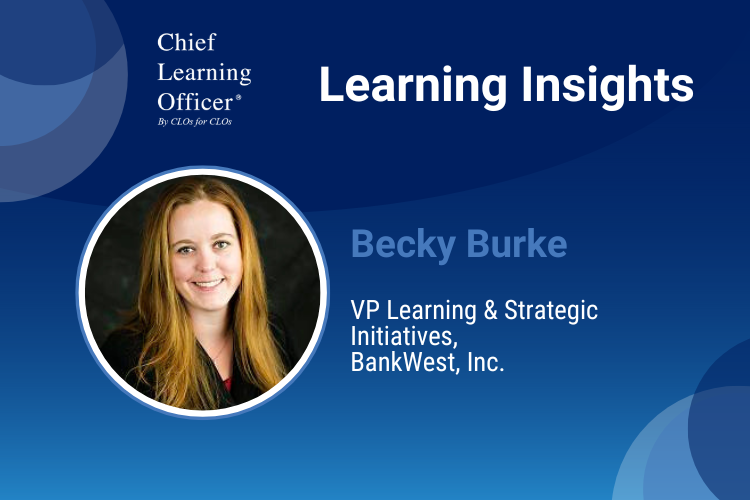Chief Learning Officer’s “Learning Insights” series is dedicated to showcasing the thoughts and career journeys of chief learning officers and learning executives—the tireless trailblazers who are transforming the landscape of corporate learning and workforce development. In this Q&A series, we garner strategic insights, innovative approaches and challenges overcome from visionary leaders worldwide.
What initially drew you to a career in learning and development, and how have your experiences evolved over the years?
I started my career at my company as a management trainee. Part of that was moving through all the areas of the bank to learn how each department and division worked. I found that when I was in the training department, and later in IT as a trainer, I enjoyed coming to work and found a passion for adult learning. As I progressed through the different areas of the bank, I kept hearing how training was not working and everything was a training issue. I decided to take action and submitted a proposal to our management team to move training out of HR into a stand-alone function.
When the department moved under my management, there was not a lot of training being done. We had a one-and-a-half-day onboarding, which was focused on logging into different systems, a two-day orientation which was held quarterly that some employees either didn’t attend or did so months after they joined the bank, a classroom teller training and limited technical training. Over the last several years, I have reimagined our training function to a holistic L&D function through renaming and rebranding the department, implementing gamification for e-learning, expanding training and development opportunities, growing the staff from a department of two to a department of seven and shifting the mindset of employees from training being a negative thing to a positive one. All this growth took us from a basic training function to an award-winning L&D function.
What key initiatives have you implemented as a learning leader to drive employee development and foster a learning culture?
We have had several initiatives as we have grown our L&D function. One big one was rebranding training to “Learning and Development” to create a holistic and positive experience for employee training and development. Another was implementing gamified microlearning for e-learning, which has proven to be more effective and engaging for our staff. We have also implemented video production, and now provide both live-action and animated training and informational videos. Along with video production, we have internal podcasts to further engage staff through meeting their learning style needs.
Our engagement with e-learning has been impressive. In 2023 there was a total of 233 courses launched in our gamification platform. BankWest TV was the most liked optional training, where 70 percent of employees enrolled themselves. The completion rate for all training (including those who enrolled in optional courses, plus mandatory courses) was 91 percent for the organization with a success rate of 99 percent. This level of engagement is phenomenal and unheard of according to our gamification platform vendor. The mindset of the organization has shifted from training being a necessary evil to something employees request and participate in.
What is the most impactful learning program you’ve introduced in your organization, and how has it contributed to employee growth and business success?
We have several learning programs that have been impactful for our organization. One that identified as an initiative within our strategic plan was our supervisor development program. We built the program from scratch, as supervisors did not have much, if any, training in the past. We now have a new supervisor workshop quarterly called NewS, ongoing e-learning for all supervisors, quarterly virtual training, and an annual one-and-a-half-day retreat. As a result, supervisors are more skilled in coaching, mentoring and problem-solving, and have a better understanding of policies, procedures, and the organization as a whole.
What is a common misconception people might have about the L&D function, and how do you address it?
A common misconception is that L&D doesn’t need to be involved in project planning. When any project is starting, it is imperative that L&D is involved from day one, and that the L&D manager and project manager have a good working relationship. When L&D is not involved in the project planning meetings, critical information and timelines could be missed, causing a rushed and ineffective training experience. We address it through constant communication between myself and the project manager—meeting a minimum of once a month—to discuss what is going on in each area. We have found this communication has been instrumental in effective project launch and training.
What excites you the most about the future of workplace learning, and how are you preparing your organization to adapt to the changing landscape?
There are a lot of great things in the works to grow workplace learning. One of the things I’m excited about most is how we can implement artificial intelligence to create better L&D experiences. There is a lot of hesitancy for generative AI, and I think it will be a widely used tool in the not-so-distant future. Generative AI will create efficiencies in L&D functions through the aid in developing instructional materials. AI can also be used to tailor learning to each person, which will allow organizations to have higher-skilled employees as they will get the training they specifically need.
What essential qualities or skills make a successful L&D leader, and how do you cultivate these traits in yourself and among your team?
A successful L&D leader must be a strategic thinker, visionary, emotionally intelligent and have exceptional time management skills. We have a formal coaching program in our organization which is where we work to further develop these skills and qualities. We also provide learning experiences for topics such as emotional intelligence for staff each year. When I have a staff member who is strong in one of these areas, I challenge them to build and execute training for others. These exercises have been positive and rewarding for both the facilitator and the learner.
What game-changing advice would you offer if you could go back in time and mentor your younger self?
I believe I am where I am because of the experiences I have gone through. Our L&D function would not be where it is without the trials and tribulations, and I don’t know that there is any advice I would give my younger self to do anything different. Each experience we face leads us down the path we are on today, and without those experiences, things would be different.
What do you feel is currently the single biggest challenge facing L&D professionals and the industry as a whole?
The single biggest challenge is the same as the biggest opportunity, and that is technology. A hot topic right now is generative AI and how it can be used and managed.
We’re always looking to showcase innovative tools and technologies. Can you share one work or learning tech product or platform that has significantly improved your work processes and why you find it valuable?
We implemented a program called SmartSheet a few years ago for our project management. We use this tool for building career roadmaps, called “Professional Development Roadmaps,” which employees use to track their L&D activities and to plan for their future career development. We also use the program for training evaluations and dashboards, time tracking for L&D activities, and tracking training attendance (to name a few).
Interested in being featured in our “Learning Insights” series? Please complete this FORM.















